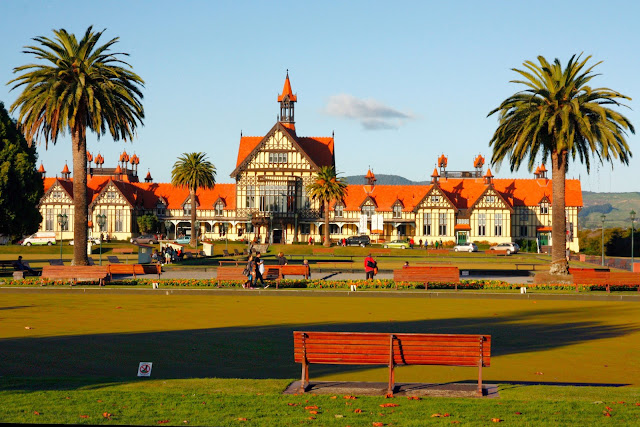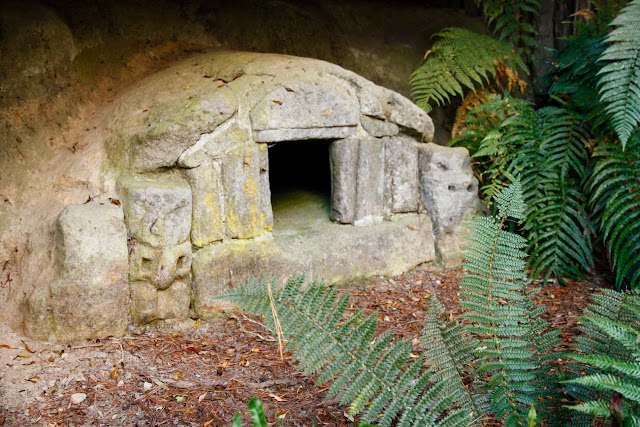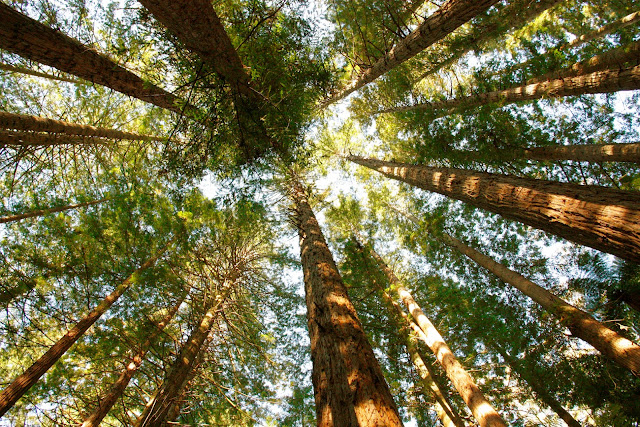We recently spent a long weekend in Rotorua and some time visiting a few of the main attractions there.
Lake Rotorua is the water filled caldera of massive volcanic eruptions. The last major eruption being 240,000 years ago. The earth's crust around Rotorua is one of the thinest on earth, 2 - 3 km. As result, hot magma drives this wonderful geothermal area.
 |
| Rotorua from the gondola and luge. Mokoia Island on the left in the middle of Lake Rotorua. |
 |
| Rotorua Museum - one of the iconic sites in Rotorua. |
The building above was originally opened in 1908 by the Government as the Bath House utilising the abundant geothermal waters. The Rotorua Museum is now here after the baths were closed and converted to house the museum in 1988.
 |
| The meeting house at Te Papaioru Marae |
 |
| St Faiths Church, Ohinemutu |
An attraction not to be missed is a walk through the redwood forest. The earliest plantings included Californian redwoods in 1901. Although only covering a small area of the forest, some of the trees are rather large by New Zealand standards. The track is relatively flat and an easy hour's walk.
 |
| One of the larger redwoods - ca.115 yr old, the tree that is. |
 |
| Silver fern in the leaf litter |
 |
| Tree fern or ponga. |
About 30 minutes south of Rotorua is one of the best geothermal areas in New Zealand at Waiotapu. We were there after a prolonged dry spell and consequently some of the pools had dried up and the area was not as I expected it to be. The Primrose Sinter Terraces in particular were suffering as there was very little water flowing down them.
One of many explosion craters near the entrance.
 |
| The green lake. |
An explosion crater filled with water coloured green by suspended colloidal sulphur and dissolved ferrous salts.
 |
| The Champagne Pool. |
The pool above is one of the top geothermal attractions here. The water is at boiling point with red iron oxides precipitated around the cooler edges. The pool was formed 700 years ago by hydrothermal eruptions.
 |
| Close up of the Primrose sinter terraces. |
The miniature terraces above cover an area of 1.5 hectares. The overflow from the Champagne Pool trickles down and deposits minerals as the water cools. The height of the little pools is around 1 cm. Because of dry conditions, little water was flowing down these terraces.
Lady Knox Geyser beginning to erupt.
The Lady Knox Geyser erupts every morning at 10:15 am. How can this be?
in 1901 an open prison was established at Waiotapu to house some of the better behaved prisoners from the Rotorua area. A gang of these discovered the spring from which the geyser erupts. When washing their clothes in the hot spring, the prisoners discovered that the soap they were using caused the geyser to erupt.
Once erupted, the chamber takes about 18 hours to refill and number of further hours to heat up and allow enough pressure to build before the next eruption.
Crowds gather from 10:00 am each morning to await the arrival of a guide who gives a brief history and explains the mechanism of the geyser's eruption. A bag of surfactant is added which lowers the surface tension between hot water in the chamber and colder water above. Within a few minutes steam begins, as in the photo above, before boiling water is erupted.
Stones added around the spring have been built up into a cone and coated with white silica over a number of years.
 |
| Lady Knox Geyser in full eruption. |
The eruption lasts up to an hour depending on conditions. Left alone, this geyser would have a longer return period and erupt to a far great height. It would certainly be more spectacular. However tourism is all about putting on a show, hence "The Lady Knox Geyser erupts every morning at 10:15 am."
On the way in to the visitor centre you go past the entrance to the mud pools.
I thought that they were not at their best because of the dry conditions. However there was plenty of activity as these two photos show.
Lake Tarawera:
 |
| Mt Tarawera across the Lake Tarawera |
Nearby is the Buried Village of Te Wairoa. This was destroyed when Mt Tarawera erupted on June 10 1886. The Pink and White Terraces were also destroyed.
 |
| Te Wairoa |
 |
| Reconstructed whare, excavated in the 1930s |
The eruption deposited approximately 1.5 m of ash and mud on Te Wairoa collapsing most buildings and burying people alive. Around 120 lost their lives on this terrible night.
 |
| Lake Rotomahana Hotel site |
The hotel was a 2 storied structure run by Joseph Macrae and collapsed under the weight of mud. It was excavated 1986.
 |
| The excavated hotel cellar |
 |
| Stone pataka (store house) was discovered recently. |
The Wairoa Stream runs down the side of the village and has spectacular waterfall (in 3 falls) which is seen from a steep track descending about 30 m.
 |
| Wairere Falls, 1 and 2 |
 |
| The third part of the Wairere Falls |






